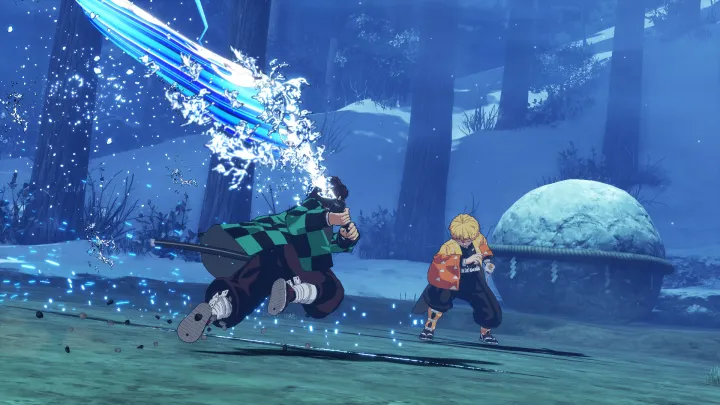Demon Slayer: Kimetsu no Yaiba — The Hinokami Chronicles is a new 3D arena fighting game based on the anime and manga series of the same name. The game comes from CyberConnect2, the same developers behind the popular Naruto: Ultimate Ninja Storm series. There are obviously a lot of similarities between the two, though I wasn’t able to notice them all due to my time with Ninja Storm being very short. However, I played enough of the series to notice that Demon Slayer takes a lot of steps forward from that IP, but a few steps backward as well.
I was able to spend a few days with this new fighter and found myself comparing it more to the somewhat recent arena fighter Kill La Kill: IF, with the assist and tag mechanics of the Ninja Storm series thrown in. That’s a good thing for those that haven’t tried either of those games out. Kill La Kill: IF is one of the most polished and well-made arena fighters I’ve ever played, so its a glowing comparison. Infuse that with the assist attack shenanigans from Naruto, and you’ve got a recipe for a super-addicting fighting game, right? Well, not without a few caveats.
Slick combat with a single blemish
Demon Slayer brings a lot to the table when it comes to combat, and some of that comes from traditional 2D fighters. Like other arena fighting games, you’ve got your light attack strings, an armored heavy attack, a jump, sidesteps, a grounded homing dash, an airdash, three ground specials and two aerial specials (all limited by a constantly recharging skill gauge), a grab, and a super (which grows stronger depending on the number of special bars you have). There are also two assist support attacks per character and the ability to switch to an assist character. This can be done through a tag-in or during specific special attacks performed by your point character to set up some pressure situations. However, those supports are limited by a bar. Support attacks and tags cost 50% while combo breakers cost 100%.

This may be one of the first arena fighting games to present an easier way out of those pressure situations. By holding guard and pressing forward, players are able to push-block. This allows them to push an opponent back during pressure, whether they’re doing it to drive them away or to make a seemingly safe attack string or special punishable. Players can parry incoming attacks, which, if done successfully, will stagger the enemy, opening them up for attack.
If that wasn’t enough, there’s also a mechanic called Boost. By spending a special bar, players can enter a mode that increases attack and speed for a limited period. Once activated, a burst barrier surrounds a fighter and acts like a Street Fighter Alpha Counter. If the player spends another bar after Boost, they enter Surge, which boosts power more and gives them infinite skill gauge for a limited time. Special bars can be used for Ultimate Art, too, which is essentially a super attack. The more bars, the stronger the attack.

I found myself instantly cooking up ideas in my head before even going into training mode thanks to this battle system. However, one feature immediately turned me off: The combo limiter. This limiter takes the form of a small circle that pops up anytime a combo starts. Depending on the combo starter, players will either have a standard or minimized time to complete the combo. While a good concept to keep combos from going too long, this mechanic feels like it needs to be toned back just a bit to work.
Fighting games are all about creativity and finding something that looks as cool as possible with the tools presented. The combo limiter just doesn’t give enough time for that without sacrificing cool-looking attacks for the sake of “balance.” It’s a great concept, but it needs some fine-tuning to keep training mode and battles feeling more open.
Half-baked features
Demon Slayer‘s combat delivers, but I can’t say the same for the rest of the package. That’s something I was hoping to never say after what happened with Street Fighter 5, which found itself in a similarly half-baked position when it was first released.
There are only four modes in Demon Slayer: Story, VS Mode (VS CPU, offline player, and online ranked and casual match), practice, and training. Those last two sound the same, but they are not at all.

The story mode is very dull so far. I expected a simple retelling of the anime in the form of fights, but got a hallway simulator. Throughout this mode, players are taken to different locations seen throughout the anime where they can talk to NPCs and gather clues to advance the plot or “explore” for in-game currency and collectibles. Once players advance the plot, they follow the scent of a demon and fight them until the end of the stage, which culminates in a boss fight. It’s a tedious rinse-and-repeat process, with some good cutscenes in between.
I originally was excited to see how the mode played out. Story modes like this have been done in anime fighters before like Naruto: The Broken Bond. But where Demon Slayer falls short is that movement is limited to a light jog (players can only jump when given a prompt at certain points). The mode is barely optional, as it seems to be necessary to unlocking stages and characters.
The practice and VS modes are standard fighting game affair. In practice, you can … well practice. The VS mode is equally self-explanatory. I wasn’t able to try out the netcode just yet (which determines how stable a game plays online) due to previews featuring no online mode.
There’s also the training mode, which would be better named “trial mode.” Players select a teacher and fight against them 10 times, with each match containing different objectives. This mode would be fine if each teacher had different battle tasks, but they all have the exact same ones. I got through three until the tedium finally sent me back to story mode to unlock characters instead of farming unlock points here.
Nailing the aesthetic
One place where the game looks to achieve utter perfection is the visual department. Demon Slayer literally looks like CyberConnect2 took the anime and made it into a game — and I’m not exaggerating. While playing, my brain often tricked me into thinking I was just watching the anime. The models, the environments, and everything else in between is breathtakingly faithful to the source material.

Demon Slayer: Kimetsu no Yaiba – The Hinokami Chronicles is sure to be a hit with fans of the anime/manga, as well as Ninja Storm fans simply looking to jump online or play their friends every now and then. But the package feels incomplete so far. With the lack of an arcade mode or survival mode, and a mediocre story mode, it seems like it won’t break too far out of its niche fandoms, both for the anime and arena fighting games in general.
Demon Slayer: Kimetsu no Yaiba — The Hinokami Chronicles launches on October 15 for PC, PlayStation 4, PS5, Xbox One, and Xbox Series X/S.



